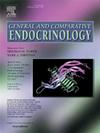GLP-1 receptor agonist properties of a chimeric peptide derived by hybridization of Latrodectus αLatrotoxin and Heloderma Exendin-4
IF 1.7
3区 医学
Q3 ENDOCRINOLOGY & METABOLISM
引用次数: 0
Abstract
Chimeric peptides comprised of amino acid sequence motifs found within hormones, neuropeptides, and insect or lizard toxins are now under investigation for their potential use in therapeutics. Here, we report the discovery of one such peptide designated as Black Widow Spider-Exendin-4 (BW-Ex-4). It consists of a putative G protein-coupled receptor (GPCR) binding domain present within αLatrotoxin (αLTX) isolated from Latrodectus, and fused to N- and C- terminal motifs found within the glucagon-like peptide-1 receptor (GLP-1R) agonist Exendin-4 isolated from Heloderma. FRET reporter assays that monitor cAMP production establish BW-Ex-4 to be a specific GLP-1R agonist without any stimulatory action at glucose-dependent insulinotropic peptide (GIP), glucagon, or corticotropin releasing hormone (CRH) receptors. Structural modeling studies of the predicted BW-Ex-4 binding sites at GPCRs of Family B provide new insights concerning the molecular basis for chimeric peptide stimulatory actions at the GLP-1R. We also report that BW-Ex-4 acts in obese hyperglycemic Leprdb/db mice to suppress appetite, lower body weight, improve glucoregulation, and to reduce circulating levels of pro-inflammatory cytokines. Collectively, these findings establish a combinatorial chimeric peptide chemistry in which αLTX serves as a molecular scaffold for the design of hybrid peptides with novel GPCR stimulating properties.

Latrodectus αLatrotoxin与Heloderma Exendin-4杂交获得的嵌合肽GLP-1受体激动剂特性
嵌合肽由氨基酸序列基序组成,存在于激素、神经肽和昆虫或蜥蜴毒素中,目前正在研究其在治疗中的潜在应用。在这里,我们报道了一种被命名为黑寡妇蜘蛛exendin -4 (BW-Ex-4)的肽的发现。它由一个推测存在于Latrodectus αLatrotoxin (αLTX)中的G蛋白偶联受体(GPCR)结合域组成,融合到Heloderma中分离的胰高血糖素样肽-1受体(GLP-1R)激动剂Exendin-4中的N端和C端基序。FRET报告试验监测cAMP的产生,确定BW-Ex-4是一种特异性GLP-1R激动剂,对葡萄糖依赖性胰岛素肽(GIP)、胰高血糖素或促肾上腺皮质激素释放激素(CRH)受体没有任何刺激作用。对B家族gpcr预测的BW-Ex-4结合位点的结构建模研究,为嵌合肽刺激GLP-1R作用的分子基础提供了新的见解。我们还报道了BW-Ex-4在肥胖高血糖Leprdb/db小鼠中起作用,抑制食欲,降低体重,改善血糖调节,并降低循环中的促炎细胞因子水平。总的来说,这些发现建立了一种组合嵌合肽化学,其中αLTX作为设计具有新型GPCR刺激特性的杂交肽的分子支架。
本文章由计算机程序翻译,如有差异,请以英文原文为准。
求助全文
约1分钟内获得全文
求助全文
来源期刊

General and comparative endocrinology
医学-内分泌学与代谢
CiteScore
5.60
自引率
7.40%
发文量
120
审稿时长
2 months
期刊介绍:
General and Comparative Endocrinology publishes articles concerned with the many complexities of vertebrate and invertebrate endocrine systems at the sub-molecular, molecular, cellular and organismal levels of analysis.
 求助内容:
求助内容: 应助结果提醒方式:
应助结果提醒方式:


